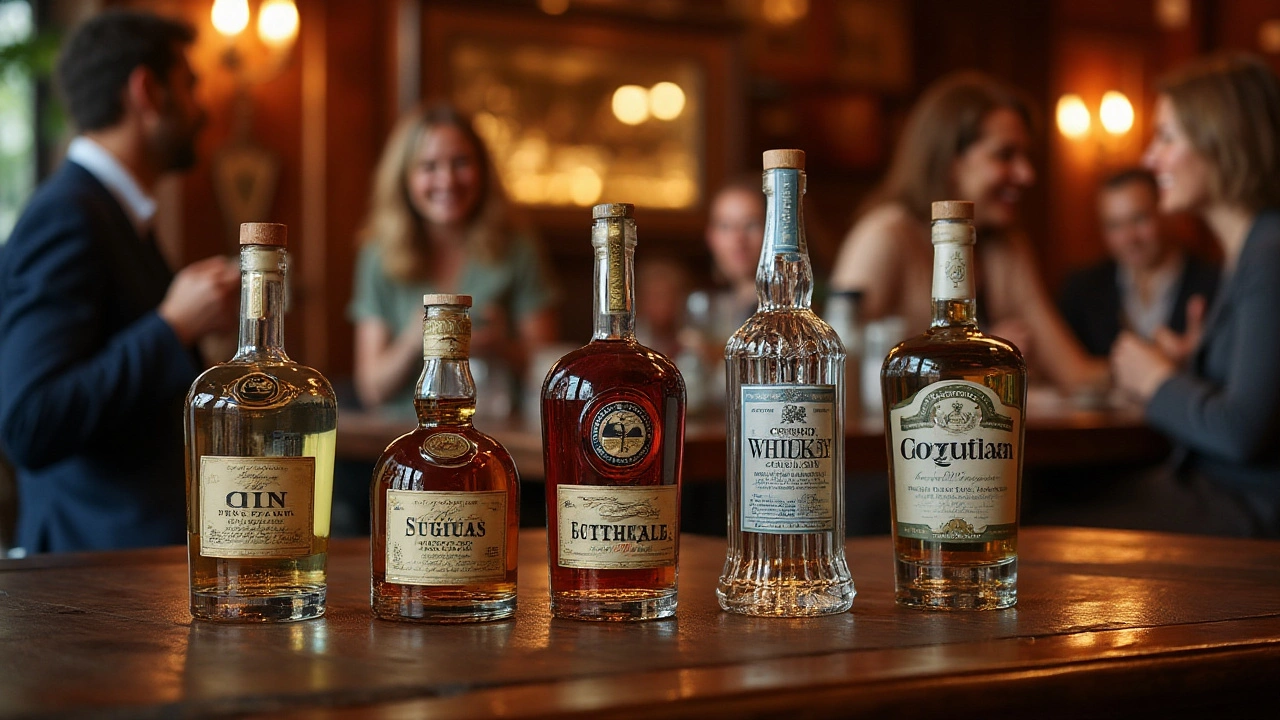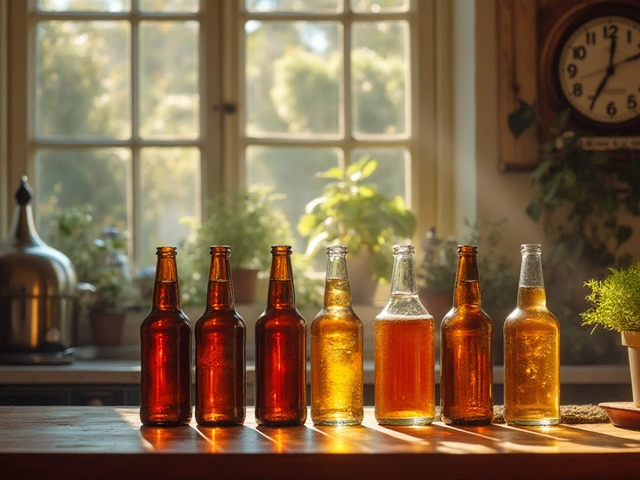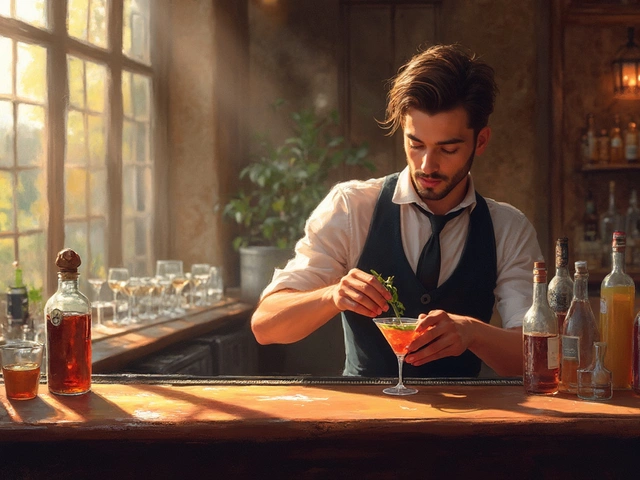In the world of spirits, each drink holds the key to a different culture, history, and legacy. For both seasoned enthusiasts and those new to the scene, understanding the variety of spirits can open a gateway to new experiences and tastes. In this article, we introduce you to the seven spirits that define the realm of alcoholic beverages.
We'll take a flavorful journey into the depths of whiskey, celebrated for its diverse and complex flavor profile developed through centuries of craftsmanship. Discover vodka's purity and adaptability, a staple in countless cocktails and a symbol of refinement. Experience the tropical allure of rum, carrying with it the whispers of oceans and sunlit plantations.
Let's not forget gin, unique for its infusion of botanicals, standing out with its refreshing, aromatic qualities. We’ll explore tequila’s deep roots in Mexican culture, crafted from the heart of the agave plant. Brandy, a warm and sophisticated sipper, captures the essence of fruit in stunning form, while liqueurs bring sweetness and spice in a more gastronomic style.
This intricate tapestry of flavors not only enriches our palates but also tells tales of human passion and tradition. Get ready to savor, learn, and perhaps find a new favorite amongst these legendary spirits.
- Whiskey: The Heart of Tradition
- Vodka: Purity and Versatility
- Rum: Sweet Echoes of the Tropics
- Gin: A Botanical Journey
- Tequila: The Spirit of Mexico
- Brandy: Capturing the Essence of Fruit
- Liqueurs: The Sweet and Spiced Creations
Whiskey: The Heart of Tradition
Whiskey, often regarded as the crown jewel of spirits, carries with it a deep sense of heritage and craftsmanship that spans centuries. From the rugged Scottish Highlands to the historic bourbon distilleries of Kentucky, the world of whiskey is as diverse as it is rich. Each bottle tells a story—of skilled artisans, unique climates, and the finest ingredients, meticulously distilled and aged to perfection. But what truly sets whiskey apart from other spirit drinks is the passion and tradition that goes into its production, making each sip a journey through time and history.
Whiskey derives its name from the Gaelic term "uisge beatha," which translates to "water of life." This potent spirit has evolved through many incarnations, with each culture adding its own flavor and flair. Scottish malt whiskey is made primarily from malted barley and is recognized for its robust and sometimes peaty flavor profile. In contrast, Irish whiskey is typically triple-distilled, resulting in a smoother taste that's often preferred by those new to the realm of whiskey. Across the Atlantic, bourbon—a distinctly American creation—boasts a sweeter, full-bodied flavor due to its minimum of 51% corn content.
Understanding the subtleties between different types of whiskey can elevate one's appreciation for this timeless beverage. A single malt whiskey is made from a single distillery using malted barley, providing a purer taste that reflects the distillery's unique environment and techniques. Meanwhile, blended whiskeys combine various malts and grains to create a more balanced and diverse flavor profile. The journey from grain to glass includes meticulous attention to detail at every step—fermentation, distillation, aging in oak barrels, and finally, bottling.
"The beauty of whiskey lies not only in its taste but in the stories and friendships it fosters," said the famed distiller Andrew Usher.
One cannot discuss whiskey without mentioning the importance of the aging process. Stored in charred oak barrels, whiskey absorbs the rich, complex flavors of the wood, with variables like climate and barrel conditions significantly impacting the end result. In colder climates, such as Scotland, whiskey tends to age slower, leading to softer notes, whereas in hotter regions like Kentucky, the spirit matures more rapidly, resulting in bold, vibrant flavors. Each bottle, therefore, becomes a unique reflection of its environment, capturing the spirit not just of the ingredients, but of the land itself.
Finally, no exploration of whiskey would be complete without understanding how to enjoy it best. While personal preference plays a significant role, there are a few guidelines that can enhance the tasting experience. Whiskey aficionados often suggest nosing the drink before tasting, allowing the aromas to prime your palate. When sipping, let the whiskey roll around your mouth to fully engage with the flavor notes before swallowing. Some prefer to add water or ice, opening up new layers of flavor, but others insist it should be enjoyed neat. The beauty lies in its versatility, as each person can find the perfect way to savor this extraordinary alcohol tasting journey.
Vodka: Purity and Versatility
Vodka, revered for its simplicity and subtlety, is an iconic spirit that has captured popular imagination and culture. Characterized by its clear appearance and neutral flavor, vodka's formation process is quite unique. Distilled to reach high proof levels, it removes almost all congeners, ensuring a pure taste profile that other spirits seldom match. This process started centuries ago in Eastern Europe, with Poland and Russia making strong historical claims over its ancestral origins. Vodka stands on its own as a base for cocktails, integrating itself seamlessly into countless recipes due to its chameleon-like nature.
Known for its versatility, vodka’s identity goes beyond being just a base spirit. When properly paired, it elevates other ingredients, lending a quiet, unobtrusive backbone that allows flavors to shine. From the crystalline cold shot savored traditionally in Russian and Polish culture to the most sophisticated of martini cocktails, vodka finds its place on nearly every bar menu across the globe. As vodka’s popularity has soared, distillers have taken to innovating both in terms of flavor and production. Infusions have become a significant trend, bringing everything from zesty citrus to smoky bacon notes into the mix, making vodka an experimenter's delight. According to Diane Morgan, author of the Art of Vodka, "The beauty of vodka lies in its ability to reinvent itself. It's a canvas for creativity, untouched yet ripe for expression."
The production process of vodka is effectively an art form. It begins with fermentable materials, often grains or potatoes, and can include fruits or sugars in more adventurous variations. The distillation process is crucial because it defines vodka’s final quality. Multiple distillations result in a cleaner, smoother spirit, and some brands proudly boast of this meticulous repetition. Filtration plays a key role, whether through charcoal or other natural elements, refining vodka down to its sleek, untainted form. The tasting notes, often understated, highlight its defining features like creaminess, light body, slight sweetness, or delicate peppery finish.
For sharp insights into vodka, one might glance at the numbers, which illustrate the factors affecting production and demand. A table with interesting statistics can reveal, for instance, that Russia, despite being globally associated with vodka, only accounted for about 2% of global vodka exports by 2021. Meanwhile, the US emerged as a major producer and consumer, highlighting shifting trends and market dynamics influencing the spirit's global landscape. Vodka's unparalleled ability to fit in virtually anywhere—from casual gatherings to high-end bars—cements its place in the world of spirits.
The journey of vodka from refinement to the finished bottle reflects a careful balance between heritage and innovation. Its timeless appeal thrives as it continues to be a staple in social gatherings and personal collections, making it a truly universal spirit. Born from humble roots, vodka embodies the spirit of possibility, ever poised to challenge expectations and surprise the palate. Whether one prefers it in a mixed drink or neat, vodka stands out not only for its distinctive purity but also for the sheer scope of its adaptability that makes it an irreplaceable part of the alcohol tasting landscape.
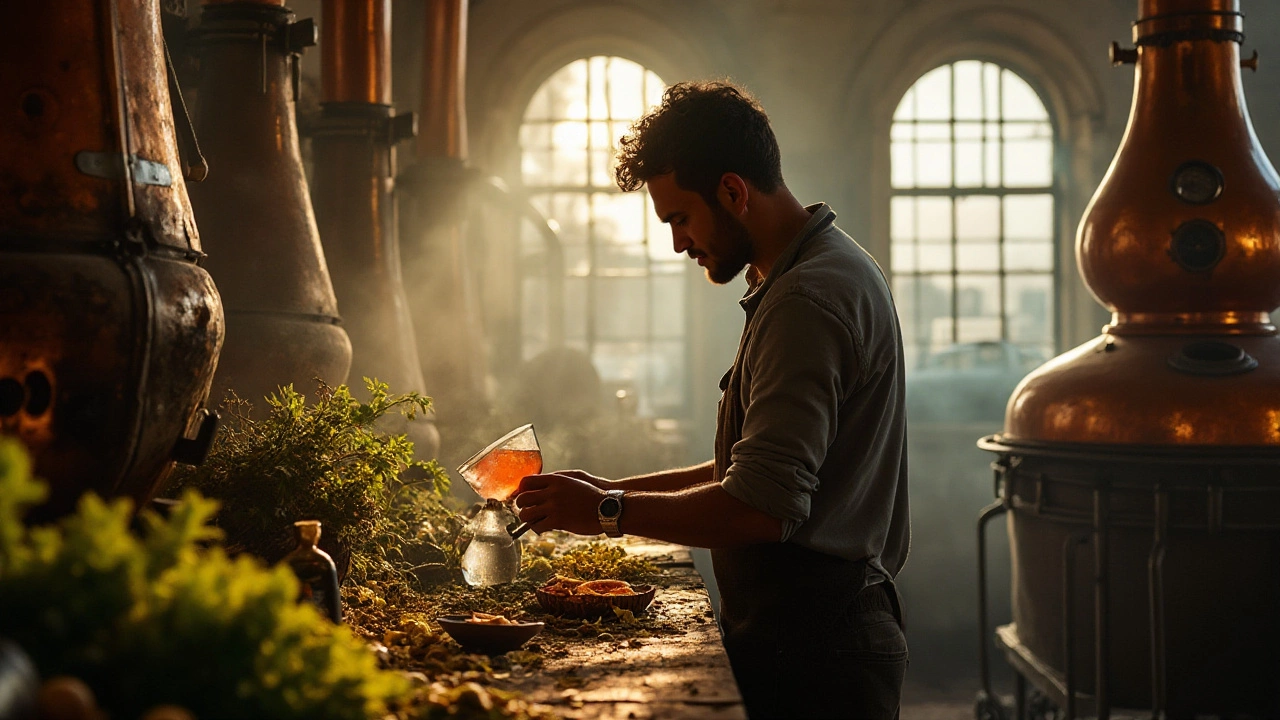
Rum: Sweet Echoes of the Tropics
The allure of rum lies in its ability to transport us to sun-soaked islands, with every sip a reminder of balmy breezes and ocean vistas. This spirit, intimately tied to the Caribbean, is crafted from sugarcane or its by-products like molasses, infusing it with a sweetness that is as versatile as it is inviting. Each region boasts its own unique styles, from the light and super smooth Puerto Rican rums often found in cocktails, to the robust and full-bodied Jamaican varieties that make a bold statement sitting neat in a glass.
Producing rum is as much art as it is science. Distillers take pride in their fermentation process, which imparts different flavor notes ranging from fruity and floral to earthy and spicy. The tropical climate, with its warm temperatures and high humidity, plays a key role in the aging process, allowing flavors to develop more quickly than in cooler climes, resulting in a mature profile in fewer years. Interestingly, the history of rum is closely intertwined with some of the more tumultuous chapters of human history, like the triangular trade and pirate lore, making it a drink with stories soaked into every drop.
Today's rum is not just about adventure, but also about elegance and complexity. For example, when you taste an amber-hued aged rum, you're not just tasting alcohol, but a symphony of flavors that might include caramel, vanilla, and tropical fruits, each telling a tale of the cask that housed it. Many enthusiasts believe that the best way to uncover these hidden notes is to sip it slowly and savor the journey. Yet, it’s also the backbone of many beloved cocktails, from the classic Daiquiri to the festive Piña Colada, making it both the star of a tasting session and the life of the party.
According to spirits expert Fred Minnick, "Rum, more than any other spirit, captures the heart of the Caribbean—it’s history in a glass." Generations have crafted this spirit to be versatile in nature, perfect for sipping neat, on the rocks, or mixed in an artful concoction. Whether you’re a casual drinker or an aficionado, there’s always something new to discover. With the increase in artisanal distilleries, many of which are turning to innovative methods and unique spice blends, the world of rum is as exciting and varied as the islands it hails from.
For those interested in numbers, rum consumption has been steadily rising, with the global rum market value expected to reach $16.1 billion by 2026. Its range, from the lighter, elegant varieties perfect for mixing, to the darker, more complex versions meant for sipping, ensures constant demand. And with such a vast choice available, there's never been a better time to expand your repertoire and sample the nuances rum has to offer.
Gin: A Botanical Journey
When it comes to spirit drinks, gin offers a unique experience that distinguishes it from others by virtue of its rich botanical harmony. The making of gin is an art that transcends centuries, rooted in a meticulous process of combining juniper berries, the cornerstone ingredient, with a symphony of botanicals such as coriander, angelica root, and citrus peel. These botanicals not only define the taste but also inspire diverse expressions across different distilleries. Gin's history is as vibrant as its flavors, with origins tracing back to the 17th century where it served not just as a drink but a medicinal tonic believed to guard against maladies such as the plague.
This spirit has undergone a remarkable evolution from its early days in Holland, where it was known as 'jenever,' to becoming the quintessential British beverage during the infamous 'Gin Craze' of the 18th century. It was a time when gin's consumption soared, leading to social issues, yet also establishing it as a staple in British culture. What makes gin truly intriguing is its versatility; it can be savored on its own, or as a key component in cocktails like the gin and tonic and the negroni, each cocktail harnessing gin’s botanical essence in distinctive ways. Interestingly, gin's revival in modern times can be partly attributed to the creative influence of artisanal distillers who have embraced traditional techniques while simultaneously pushing the boundaries with new exotic botanicals.
The process of distillation plays a crucial role in determining the quality and flavor profile of gin. According to a master distiller at a leading craft gin company, "The essence of a truly magnificent gin lies in its ability to balance the complex interplay of its botanicals, each coming together without overpowering the others." This emphasizes the nuanced craft that goes into each bottle, highlighting the importance of transparency about the ingredients and techniques used. Many gin enthusiasts appreciate knowing the story behind their drink, which fosters a deeper connection to the spirit.
The global gin market is thriving, driven by the increased demand for premium and craft gin, as well as the rise of gin bars in urban metropolises. Factors such as a growing inclination towards cocktails among millennials, an increased awareness, and the influence of social trends have all played a part in the resurgence of gin. According to data from a recent spirits report, the global gin market was worth $20 billion in 2023 and is projected to grow steadily at a rate of 5% annually over the next few years. This includes an increasing number of craft gin distilleries emphasizing sustainable and locally sourced ingredients, reflecting broader consumer trends toward environmental consciousness and authenticity in consumption.

Tequila: The Spirit of Mexico
Tequila is not merely a drink; it's a gateway to the captivating culture and rich history of Mexico. This iconic spirit, rooted in tradition, is crafted from the blue agave plant, primarily in the area surrounding the city of Tequila, which lies in the state of Jalisco. The production of tequila is an art form passed down through generations, embodying both a deep respect for the past and a celebration of innovation. The agave plant grows for about eight to twelve years, and only when it reaches the peak of its development is it harvested by skilled jimadores. These experts wield their sharp tools with precision, cutting away the leaves to reveal the heart of the agave, known as the piña, which is later cooked and fermented to begin its transformation into tequila.
The uniqueness of tequila lies in its regional origins and the variety of flavors it offers. Unlike other spirit drinks that boast a universal production process, tequila's essence is deeply tied to its terroir and the meticulous methods used in its creation. It is broadly categorized based on the aging process, resulting in distinct varieties such as Blanco, Reposado, and Añejo. Blanco is unaged, capturing the raw, fresh essence of the agave. In contrast, Reposado is aged for a minimum of two months, often embodying a smooth taste with notes of oak and vanilla, while Añejo matures for at least a year, offering a more complex palette of flavors. This differentiation allows drinkers to explore a spectrum of tastes and sensations, each sip telling its own story.
"Tequila is magic," said Juan Beckmann Vidal, a renowned figure in the industry. "It's a spirit that transforms what is essentially a spiky plant into an experience that can be shared and celebrated the world over."
Due to its popularity, tequila consumption has grown substantially on a global scale. According to recent data, the United States alone imports over 200 million liters annually, illustrating a significant appreciation outside its homeland. Tequila is not limited to neat or on-the-rocks consumption. Its versatility shines in the realm of cocktails, with the Margarita being arguably the most famous. This blend of tequila, lime juice, and Cointreau, served in a glass with a salted rim, has captured vast audiences with its refreshing taste. Each glass of tequila, whether imbibed straight or mixed into a cocktail, offers a taste of tradition and the vibrant spirit of Mexican culture.
Brandy: Capturing the Essence of Fruit
Brandy is much more than just a spirit; it’s a journey through time and taste, drawing from the rich flavors of ripened fruit, traditionally grapes. Originating in the early 16th century, brandy was initially crafted as a method to preserve wine and reduce transport costs. The word itself comes from the Dutch word 'brandewijn,' which means 'burnt wine,' referring to the distillation process. This technique concentrates the fruit’s essence into a bold, warm spirit, revealing a tapestry of flavors that delight the senses. Whether sipped neat, warmed, or mixed, the complex character of brandy remains a testament to the artistry of distillation.
The process of making brandy typically begins with fruits that are fermented to make wine or a fruit mash, which is then distilled to produce brandy. Grapes are the most commonly used fruit, but apples, pears, and apricots can also craft distinctive brandies. Once distilled, the spirit matures in oak barrels, where it absorbs tannins and flavor compounds, adding depth and color to the liquid. The length of aging, often several years, plays a crucial role in defining the distinctive caramel, vanilla, and spice notes appreciated by enthusiasts.
Brandy originates from many regions, each offering its take on the spirit. Cognac, perhaps the most famous type, hails from a specific region in France, known for its superior quality and adherence to strict production laws. Armagnac, another renowned French brandy, is often handcrafted using unique grape varieties, giving it a bolder and more rustic profile. Spain offers its version with Brandy de Jerez, known for a smooth, sweet character due to its sherry cask aging. In the New World, California brandies carry a spectrum of flavors influenced by diverse fruit selections and innovative methods.
The Varied World of Brandy
Not confined to a single style, brandy offers a spectrum of variations that cater to a range of tastes. Fruit brandies, or eau-de-vie, capture the essence of various fruits like apple or cherry, renowned for their crisp and clear flavors. Some producers distill aromatic or fortified wines, creating rich expressions with individual characteristics. Aged brandy varieties, often labeled as XO or VSOP, promise a sophisticated sensory experience with every sip. With such diversity in brandy-making traditions, the spirit brings together methods and preferences from around the globe.
Savoring Brandy
Enjoying brandy can be as diverse as the spirit itself. Many prefer sipping it neat, allowing the soft flavors to unfold on the palate unhindered. For a more intense aromatic experience, some choose to warm the brandy slightly in their hands before drinking. The spirit also plays a starring role in classic cocktails like the Sidecar or Brandy Alexander, where it blends harmoniously with citrus notes and creamy textures. Regardless of how you enjoy it, the art is in taking your time, appreciating the craftsmanship that distillation and aging impart.
"Brandy, when so distilled as to surpass the general run of spirits, can offer an extraordinary journey, not just confined to the body but awakening the mind as well." — An Enthusiast of Fine Spirits
Deciding on a preferred brandy could lead one into intriguing territories of the fruity, the floral, the earthy, or even the spicy domains. But diving into this experience is surely rewarding for every enthusiast, offering endless discoveries and flavor traditions waiting to be unveiled. Let the world of brandy embrace your palate and transport you through its diverse aroma and taste landscapes.
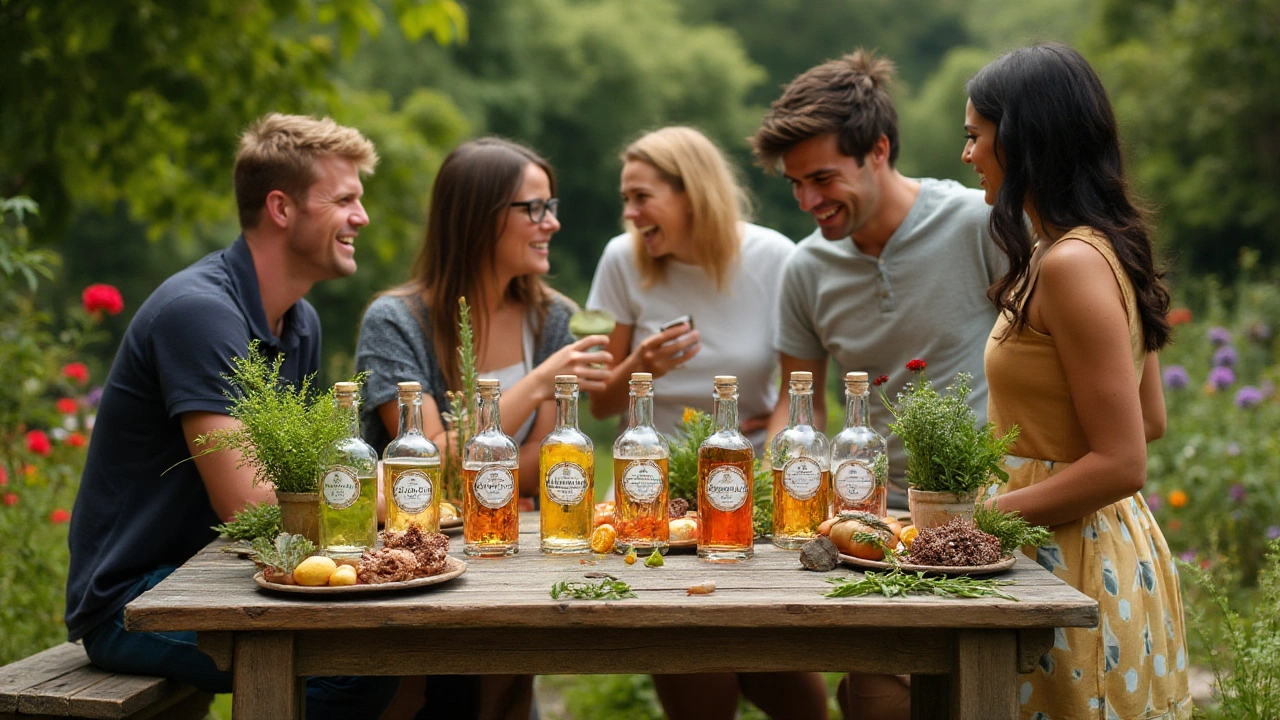
Liqueurs: The Sweet and Spiced Creations
Liqueurs carve out their own niche in the spirits world, celebrated for their delightful fusions of sweetness, spice, and an array of flavors. These potent concoctions boast histories as rich and colorful as their taste profiles. From indulgent after-dinner sips to essential ingredients in classic cocktails, liqueurs enchant with their versatility and flair. Distillers often play the role of alchemists, turning sugar, herbs, fruits, and spices into golden liquids that continue to captivate our imaginations and taste buds.
Take, for instance, Baileys Irish Cream. A product of Irish innovation, it's an exquisite blend of cream and Irish whiskey, wrapped in flavors of cocoa and vanilla. Since its introduction in the 1970s, Baileys has set a standard for creamy liqueurs worldwide, finding its place in everything from coffee pairings to dessert recipes. Another noteworthy liqueur is Amaretto, hailing from Italy. This almond-flavored elixir evokes centuries-old tales, with some attributing its origins to a romantic 16th-century tale in the region of Saronno.
The spiced universe of liqueurs also includes the beloved Drambuie, a Scottish wonder made from malt whiskey, heather honey, and a medley of secret herbs. Known for its role in the classic Rusty Nail cocktail, Drambuie offers a warm, herbal complexity that lingers lovingly on the palate. Chartreuse stands as another fine example. Crafted by Carthusian monks since the 18th century, this liqueur’s recipe marries over 130 herbs and plants. Its vivid green hue and intricate taste tell stories of devotion and craftsmanship.
"Liqueurs invite us into a world where creativity knows no bounds," says renowned spirits expert Cheryl Harrison. "They offer a canvas where distillers experiment with endless combinations, resulting in drinks that excite and delight."
Today's market brims with a dazzling array of liqueurs. There's Kahlúa, a Mexican coffee-flavored liqueur that lends its rich aroma to signature beverages like the White Russian. Or Cointreau, the French orange delight, essential for Margaritas and Cosmopolitans. Liqueurs not only cater to a variety of palates but also highlight the cultural and geographical diversity of their origins, each bottle a journey unto itself.
| Liqueur | Origin | Main Flavors |
|---|---|---|
| Baileys Irish Cream | Ireland | Cream, Whiskey, Cocoa, Vanilla |
| Amaretto | Italy | Almond |
| Drambuie | Scotland | Whiskey, Honey, Herbs |
| Chartreuse | France | Herbal |
From celebrations to quiet evenings, liqueurs stand as perfect companions, offering diversity and mystique. They remind us of the sheer creativity that drives the crafting of spirit drinks. Whether you indulge in the familiarity of a comforting sip or dare to explore a new blend, each encounter brings joy. As you sip these sweet and spiced creations, you're not just tasting a drink; you're taking part in a tradition woven across cultures and time.
